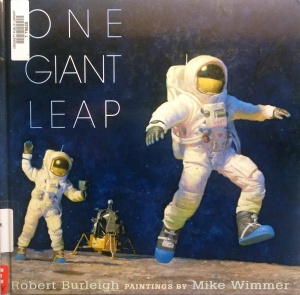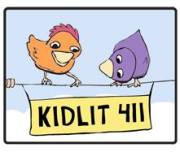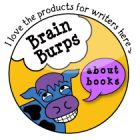14:14 PB ELEMENTS – One Giant Leap – PACING
 When I told my 6-year old granddaughter that I had actually watched this real story take place live on television…she didn’t seem impressed. It made me wonder if a child in today’s world can imagine the breath-holding tension and awe that millions experienced in that moment. Using the story element of PACING, I think this book makes a valiant effort to relate the immensity of the event.
When I told my 6-year old granddaughter that I had actually watched this real story take place live on television…she didn’t seem impressed. It made me wonder if a child in today’s world can imagine the breath-holding tension and awe that millions experienced in that moment. Using the story element of PACING, I think this book makes a valiant effort to relate the immensity of the event.
One Giant Leap
author, Robert Burleigh
illustrator, Mike Wimmer
(c) 2009, Philomel Books
(1,461 words, AR Reading Level 3.0)
It took some reflection to determine which story element to highlight for this title. I find good use of word play, with imagery and metaphor. Of course there’s plot, with the events leading to climax (the ‘one small step’) and resolution (return to earth).
But glancing back at each page, I see a solid pattern of pacing the author employed to set, maintain, and increase tension and page-turn for the reader.
Consider the last lines of the text for each sequential spread:
“At 8000 feet, it tilts and straightens. Brakes its descent. Slows. Drifts down through space.”
“The surface gouged and cratered…Like a battlefield from some ancient war.”
“He glances again at the flashing dial: fuel running short. Where can he land?””The small craft touches down. Whew!”
“We did it. We’re here.”
“No water. No wind. No sound. No life at all. Unbelievable.”
“In orbit, Michael Collins listens. And waits.”
The teases above make the reader ask, respectively:
Will it land safely?
Battlefield? Dangerous?
Not enough fuel? Will they land in a hole?
Whew! Now what?
Great! What do they do now?
Are they about to be the first life there?
What is Collins waiting for?
As the reader asks these questions internally, the tension grows, the excitement expands. I think that the pacing helps relate the feeling of ‘first ever-ness’ that rightfully accompanies this historical achievement.
Pacing can be related by anticipation and surprise, flow, cause and effect, questions. All of these tools seem to be in play with this story, to great effect. Thanks Mr. Burleigh.
I’ll read this again to my granddaughter, and pause just a little bit more before each page turn, to add my own pacing based on experience. But of course, she’ll view the moment not in black and white, but in full color. Thanks Mr. Wimmer.
Who knows? In her lifetime, she might be on vacation to the moon when she watches the first man or woman step onto Mars.
(See a list of other reviewers posts in Christi’s latest post at Write Wild.)








It’s always amazing to me to see how fast kids lose perspective. 😉
What a great example of pacing! And, yes, it isn’t easy to help children understand the importance of such an event. This kind of stuff seems almost commonplace to them today.
sounds like it is very well-written.and an excellent example of pacing. I think both girls and boys would enjoy it. Thanks for posting. I’ll keep my eyes out for this one.
I love the anticipation aspect you found in the pacing! Too cool!! Thanks for sharing.
Those lines are page turners. Great example of pacing.